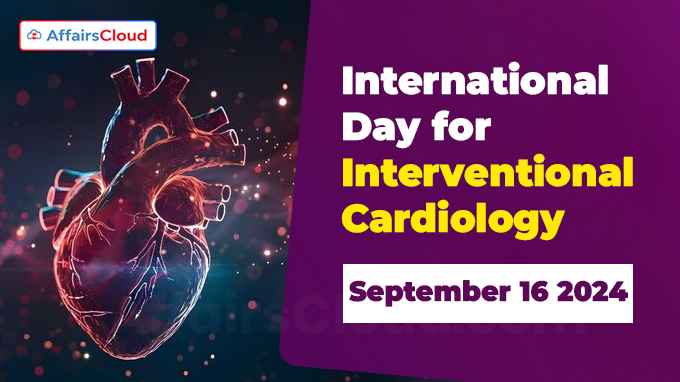 The United Nations (UN)’s International Day for Interventional Cardiology is annually observed across the globe on 16th September to raise public awareness about Cardiovascular Diseases (CVDs), and interventional cardiology procedures.
The United Nations (UN)’s International Day for Interventional Cardiology is annually observed across the globe on 16th September to raise public awareness about Cardiovascular Diseases (CVDs), and interventional cardiology procedures.
- 16th September 2024 marks the 2nd International Day for Interventional Cardiology.
Significance:
i.The day promotes prevention strategies and care for heart disease through education and the mass media.
ii.The day celebrates the continuous advancements in Interventional Cardiology that have revolutionised heart care and improved patient outcomes worldwide.
Background:
i.On 2nd September 2022, the UN General Assembly (UNGA) adopted the resolution A/RES/76/302, proclaiming the 16 September of every year as International Day for Interventional Cardiology.
ii.The first-ever International Day for Interventional Cardiology was observed on 16th September 2023.
- The resolution also invites the World Health Organization (WHO) to facilitate the implementation of the International Day for Interventional Cardiology.
Why 16 September?
16 September commemorates the first coronary angioplasty performed by Dr. Andreas Roland Grüntzig, a German physician-scientist, in 1977, at the University Hospital Zürich (USZ) in Zürich, Switzerland.
- He developed the procedure known as Percutaneous Transluminal Coronary Angioplasty (PTCA) to treat coronary artery disease.
What is Interventional Cardiology?
i.Interventional Cardiology is a specialised branch of cardiology that focuses on using minimally invasive, catheter-based techniques to diagnose and treat CVDs.
- These minimally invasive approaches often result in shorter recovery times and fewer complications than open-heart surgery and enhance patients’ quality of life.
ii.Interventional cardiologists perform procedures like angioplasty, stenting, and valve repairs through small incisions, often accessing the heart via blood vessels.
iii.They address Coronary Artery Disease (CAD), structural heart problems, Peripheral vascular disease (PVD), etc.
Key Facts:
i.According to the WHO, Non-Communicable Diseases (NCDs) such as heart disease, stroke, cancer, diabetes, and chronic lung disease, collectively account for almost 70% of global deaths.
- WHO’s “Global Action Plan for the Prevention and Control of NCDs 2013-2020” aims to reduce the number of premature deaths from NCDs by 25% by 2025 through 9 voluntary global NCD targets.
ii.CVDs are the leading cause of death worldwide. Over 75% of CVD-related deaths occur in Low- and Middle-Income Countries (LMICs).
iii.CVDs are a group of disorders of the heart and blood vessels, causing 17.9 million deaths in 2019, representing 32% of all global deaths.
- Out of the 17 million premature deaths (under the age of 70) due to NCDs in 2019, 38% were caused by CVDs.
- 85% of these deaths result from heart attacks and strokes.
iv.Addressing behavioural and environmental risk factors can significantly reduce the incidence of CVDs. Key risk factors include:
- Tobacco use
- Unhealthy diet and obesity
- Physical inactivity
- Harmful alcohol consumption
Management and Treatment:
i.The Universal Health Coverage (UHC) package should include CVD management interventions.
ii.Countries require investment in healthcare systems to manage CVDs effectively.
iii.Treatments may involve surgical operations like Coronary Artery Bypass Grafting (CABG), Balloon Angioplasty (BA), valve repair/replacement, etc.
About World Health Organisation (WHO):
Director-General (DG)– Dr Tedros Adhanom Ghebreyesus
Headquarters– Geneva, Switzerland
Founded– 1948




